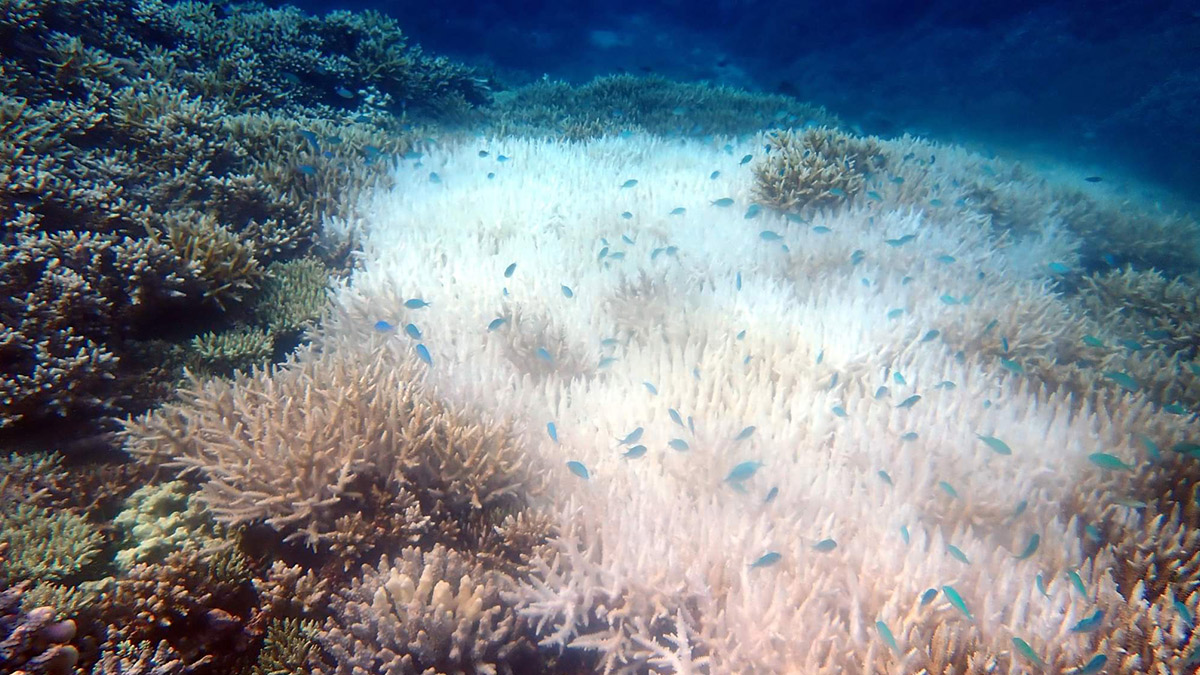Coral bleaching hits Tubbataha due to extreme heat

WHITE PATCHES This photo taken on May 27 shows the coral bleaching, or patches of white on once colorful coral beds, at the South Park dive site of the Tubbataha Reefs National Park that is blamed on the extreme heat caused by the El Niño phenomenon. —photo courtesy of the Tubbataha Reef National Park
PUERTO PRINCESA CITY, PALAWAN, Philippines — The Tubbataha Reefs Natural Park (TRNP) is suffering from coral bleaching due to prolonged heat brought by the El Niño phenomenon, a report from the Tubbataha Management Office said.
TRNP Superintendent Angelique Songco said the coral bleaching was initially thought to be “minor” and at “a lesser degree than expected” until she saw the photos taken from the park’s South Park dive site of the reef’s north atoll on May 27.
According to Songco, the photos she received from marine park ranger Jeffrey David, taken from South Park, north Tubbataha, showed that “the real deal is beginning—no, it has begun—and we cannot do anything about it!”
READ: Experts say coral reef bleaching near record level globally because of ‘crazy’ ocean heat
“By now, the corals our group admired just last week may be stressed, if not dead,” she revealed in a blog post “Mama Ranger Diaries” in the park’s official Facebook page last May 28. (Songo is popularly known as “Mama Ranger” to park rangers).
Article continues after this advertisementThe 97,030-hectare park, which is under the jurisdiction of Palawan province’s Cagayancillo town and located around 146 kilometers (91 miles) southeast of this city, lies in the middle of the Sulu Sea and forms part of the coral triangle and is considered the center of the country’s marine biodiversity. It is home to around 360 coral species, representing 75 percent of known coral species, and not less than 600 or 40 percent of the world’s reef fish, including 11 shark species, 13 dolphins and whales, and around 100 bird species. Its sandbars are also known as nesting grounds for Hawksbill and green sea turtles.
Article continues after this advertisementREAD: Australia’s Great Barrier Reef hit by record bleaching
In patches
It was declared as a national marine park by virtue of Presidential Proclamation No. 306 signed by then President Corazon Aquino on Aug. 11, 1988. It was the first marine area in the country to be declared as a national park.
In December 1993, it was included by the United Nations Educational, Scientific and Cultural Organization (Unesco) in its prestigious World Heritage List.Assistant Park Superintendent Retch Alaba said they have yet to determine how much of the park was affected by bleaching.
The only identified affected spot, so far, was the South Park dive site in the North Atoll of the reef and its surrounding areas.
Alaba, in a phone interview on Friday, said that the bleaching was observed to have occurred in patches.
She also said that, based on projections from the National Oceanic and Atmospheric Administration for Tubbataha, the bleaching has just begun.
“True enough, we have just received bleaching reports from park rangers and dive boats that are there now,” she said, adding that they first received reports last May 25.
She also said that while the observed bleaching was still small at the moment, a research team was now in the area to monitor the situation.
“We are visiting other sites for another survey so the sites that we go to and dive [at] are areas that tourists do not go to. So now, we saw that in the one hour that we were underwater that there were more corals damaged,” Songco said in an interview Saturday after she joined a dive earlier in the day.
Branching corals
The World Wildlife Fund for Nature (WWF), on its website, explained that coral bleaching happens when corals lose their vibrant colors and turn white when the ocean environment gets too hot, forcing the stressed coral to expel the algae (zooxanthellae) that gives it its colors.
“As the algae leaves, the coral fades until it looks like it’s been bleached. If the temperature stays high, the coral won’t let the algae back, and the coral will die,” the WWF said.
Alaba said corals damaged in Tubbataha are Acropora and Millepora types or branching corals, which are most vulnerable to bleaching.
She added that the damage might still grow because the waters surrounding Tubbataha are still getting warmer.
“But we hope that with the onset of the rainy season and if La Niña comes in, the waters might cool down. Although it is still relatively hot since the past few weeks, it might still take a while,” she explained.
The last time a coral bleaching with significant damage was recorded in different areas of Tubbataha Reefs was in 2020 when the El Niño weather phenomenon, characterized by a prolonged dry spell, also struck beginning in the third quarter of that year.
The park’s management said on the TRNP website that up to 20 percent of the hard coral cover of the park was affected and “continued to decline in 2021, indicating that some sites failed to recover from its impacts.”